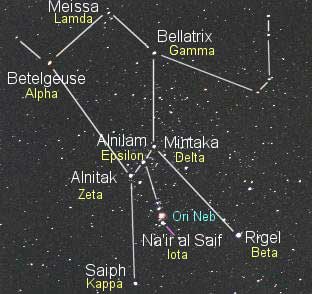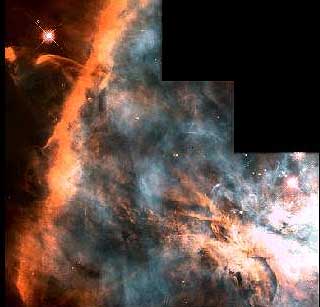
Orion's Penis
by Rehman Rashid
Stars move. Orion, magnificent Winter Hunter of the northern skies, wasn't always there, and he won't be there forever. The dinosaurs didn't see him. It took eons, but by perhaps 500,000 years ago the several stars of Orion had drifted into the arrangement familiar to us today. In about that time hence, they will have drifted apart and Orion will be no more.
Therefore, when we consider the role of the constellations in our own human mythology, we are considering an entirely human construct. There's nothing written in the stars but our own fanciful join-the-dot imaginings. A million years from now, if humans still exist and require a mythology, they'll have to pick out a whole new menagerie of constellations with which to play out their fabulous, whimsical fairytales.
Nonetheless, Orion is awesome, and would have been just as awesome to every human that ever existed before us. So clearly visible to the naked eye are the Meissa cluster of his head, flanked by his shoulders, the blazing giants Betelguese and Bellatrix, Woman of War. Below them, his brilliant belt of three stars, which may have anchored the alignment of the Pyramids of Giza. Below them, his feet, Rigel and Saiph, by the right heel of which sits his faithful companion, Sirius, the Dog Star. (The only star mentioned by name in the Quran, and, along with Vega, one of the few stars that doesn't move relative to us - these are the "fixed stars", and they may have been our planet's steady companions since the dawn of time. The dinosaurs would have seen Sirius.)
And there, of course, dangling from his belt: Orion's Sword.
That ain't no sword.
How could proto-man, on first seeing Orion above him, have seen a "sword" there? They hadn't been invented yet. It's too obvious what that line of stars would have signified in that constellation long, long ago, before the bare-naked truth became shrouded in the heavy drapes of human myth and fable. Is it not wonderful, then, that the Hubble Space Telescope should have revealed that the brightest star in Orion's Dick isn't a star at all but a nebula, and that within this seminal cloud, protostars are forming?
Our distant descendants might
yet get to see Orion come before he goes.

Rehman Rashid
Kuala Kubu Baru
August 2001